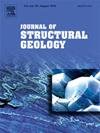Differential salt-related structural deformation in the Eastern segment of the Qiulitage fold and thrust belt, Kuqa Foreland Basin: Evidences from seismic interpretation and numerical simulation analysis
IF 2.9
2区 地球科学
Q2 GEOSCIENCES, MULTIDISCIPLINARY
引用次数: 0
Abstract
The dymatic mechanisms of salt-related structural deformation in the foreland fold-and-thrust belts have been paid more and more attention for significance in hydrocarbon exploration. The Qiulitage Fold-and-Thrust Belt (QFTB) in the frontal Kuqa Foreland Basin(KFB) has been regarded as an important study area for its complicated deformation features and potential oil and gas resources. In the eastern QFTB, sub-salt fault-bend folds show a clear transition from a single row of basement-involved thrust belts in the east to a multi-row caprock detachment thrust belt in the west.This study uses discrete element numerical simulations, based on a geological model derived from seismic data, to validate and improve the model's reliability. This research investigates the factors controlling differential structural deformation in the QFTB. These simulations are mainly explored the impact of Jurassic-Triassic detachment layer thickness, stratal dip angle, and the role of dual salt layers. The results indicate that the detachment layer enhances the décollement thrusting effect, with thicker detachment layers leading to stronger décollement thrusting. If the detachment layer is too thin to support décollement thrusting, basement-involved faults develop instead. When the lower detachment layer is less than 800 m thick, two sets of basement-involved faults form, resulting in shorter thrust distances. Conversely, when this layer exceeds 800 m, only one set of basement-involved faults forms, along with two sets of caprock detachment faults at the frontal thrust belt, resulting in relatively greater thrust distances. Stratal dip angle is equivalent to the ancient topography which can restrain the formation and development of the thrust system, with steeper detachment layer angles reducing thrust distance and causing salt accumulation. In a dual-salt layer environment, the compaction of the overlying strata is weakened, which in turn enhances the décollement thrusting effect. The double salt layers of the Jidike and Kumugelemu Formations promote the development of multiple thrust fault arrays and enlarge the scale of frontal secondary anticlines. Therefore, the segmented differential deformation in the QFTB is influenced by the interplay of deep geological structures, detachment layers, and salt layer development. This study integrates seismic interpretation and numerical simulation to investigate the genetic mechanisms of segmented deformation in the QFTB, providing valuable insights and solid evidence for structural interpretation and hydrocarbon exploration in analogous salt-detachment systems.
库车前陆盆地丘里塔格褶皱冲断带东段与盐有关的差异构造变形:来自地震解释和数值模拟分析的证据
前陆褶皱冲断带盐性构造变形动力学机制在油气勘探中越来越受到重视。库车前缘前陆盆地的丘里塔格褶皱冲断带因其复杂的变形特征和潜在的油气资源而被认为是一个重要的研究区域。在青藏断裂带东部,盐下断弯褶皱由东部单排基底冲断带向西部多排盖层滑脱冲断带明显过渡。本研究采用离散元数值模拟方法,基于地震资料导出的地质模型,验证并提高了模型的可靠性。本文研究了控制QFTB差异构造变形的因素。这些模拟主要探讨了侏罗系—三叠系滑脱层厚度、地层倾角以及双盐层的作用。结果表明:分离层的存在增强了反冲效果,分离层越厚,反冲效果越强;如果剥离层太薄而不能支持反冲,则发育基底断层。当下拆离层厚度小于800 m时,形成两套基底断层,冲断距离较短。相反,当该层位超过800 m时,只形成一套基底断裂,并在前缘冲断带形成两套盖层滑脱断裂,导致冲断距离相对较大。地层倾角相当于古地形,对冲断体系的形成和发育起抑制作用,较陡的滑脱层角减小冲断距离,有利于盐的聚集。在双盐层环境下,上覆地层的压实作用被削弱,这反过来又增强了反冲作用。吉底克组和库木格勒木组双盐层的发育,促进了多个逆冲断层阵列的发育,扩大了前缘次背斜的规模。因此,QFTB的分段差异变形受深部地质构造、滑脱层和盐层发育的相互作用影响。本研究将地震解释与数值模拟相结合,探讨了QFTB分段变形的成因机制,为类似盐滑脱体系的构造解释和油气勘探提供了有价值的见解和坚实的证据。
本文章由计算机程序翻译,如有差异,请以英文原文为准。
求助全文
约1分钟内获得全文
求助全文
来源期刊

Journal of Structural Geology
地学-地球科学综合
CiteScore
6.00
自引率
19.40%
发文量
192
审稿时长
15.7 weeks
期刊介绍:
The Journal of Structural Geology publishes process-oriented investigations about structural geology using appropriate combinations of analog and digital field data, seismic reflection data, satellite-derived data, geometric analysis, kinematic analysis, laboratory experiments, computer visualizations, and analogue or numerical modelling on all scales. Contributions are encouraged to draw perspectives from rheology, rock mechanics, geophysics,metamorphism, sedimentology, petroleum geology, economic geology, geodynamics, planetary geology, tectonics and neotectonics to provide a more powerful understanding of deformation processes and systems. Given the visual nature of the discipline, supplementary materials that portray the data and analysis in 3-D or quasi 3-D manners, including the use of videos, and/or graphical abstracts can significantly strengthen the impact of contributions.
 求助内容:
求助内容: 应助结果提醒方式:
应助结果提醒方式:


